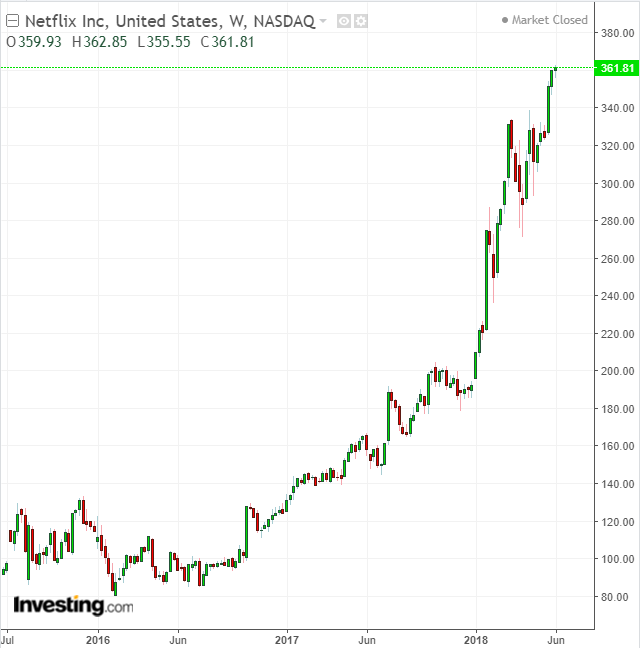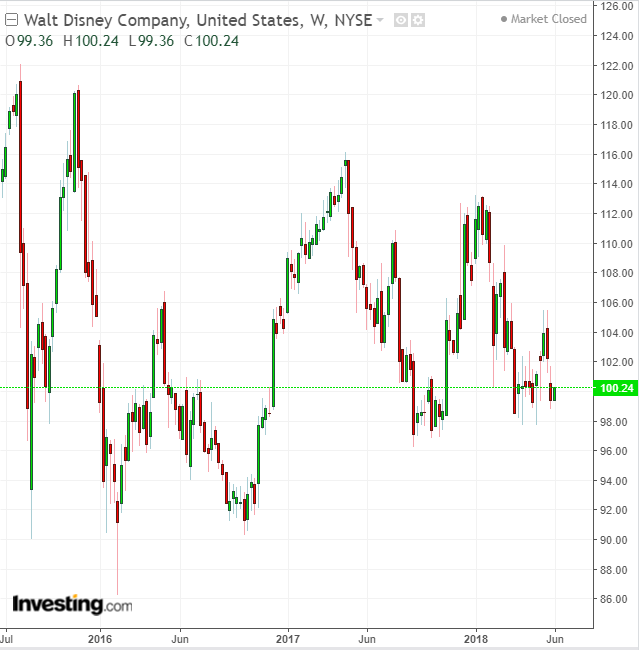With each passing day it seems Netflix (NASDAQ:NFLX) shares just keep pushing higher and higher. Last week, this video streaming service and television network, currently trading near its all-time high of $363, hit another benchmark as well. It surpassed established media giant Disney's (NYSE:DIS) market capitalization of a bit more than $$148 billion, to become the world’s most valuable media company with a current market cap of $156.46B at time of writing, fueled by the rally that has propelled its shares to new highs; NFLX closed yesterday a $361.81.

The company's valuation, a function of Netflix's stock price and the number of shares outstanding, shows how strongly investors believe in Netflix’s success and its global expansion program. In a recent note, RBC Capital Markets analyst Mark Mahaney raised his five year outlook for subscribers and earnings and said Netflix stock could have a price range of $450 to $750 within three years. That means up to a 100% boost if Netflix shares touch the upper limit of his forecast from their current level.
Mahaney’s bullish scenario is based on Netflix’s global subscriber numbers hitting 235- to 265-million by 2022. His estimate assumes that Netflix will reach about 70% penetration of U.S. broadband households and 33% in international broadband households. These are very threatening numbers for the world’s traditional media giants who are now also Netflix main competitors. The disruption caused by the Netflix’s explosive growth has fueled a major shakeup within the industry. Indeed, merger and acquisition activity is heating up—Disney's proposed acquisition of Twenty-First Century Fox (NASDAQ:FOX) could still be undermined by a competitive Comcast (NASDAQ:CMCSA) bid.
Still, before going out and excitedly buying Netflix shares, it's critical to understand the difference between a mature media company, such as Disney, and an industry disruptor which in this case is Netflix. It's also important to comprehend why investors are willing to pay much more per share for an 11-year-old app that charges just $11 a month for its streaming package than they would for a more established media company—Disney shares closed yesterday at $100.24.
Rapidly Changing Media Landscape
Despite the fact Netflix brings in a fraction of the revenue each quarter that Disney does, investors favor Netflix because the company has a first-mover advantage and is thus expected to fuel higher growth. Traditional media companies have been very late to adopt the video streaming model and they are also bogged down by their legacy media businesses.
For example, Disney’s cable unit is losing viewers who are cutting the cord in favor of cheaper video streaming services. ESPN's domestic viewers fell by 2 million to 88 million last year, along with similar setbacks at ESPN2, ESPNU, ESPNews, and the SEC Network.

These pressures, along with the rapidly changing media landscape, have weighed on Disney shares even while Netflix vaulted way past the House of Mouse. During the past five years, Netflix stock surged more than 100-fold, while shares of Disney returned just 57% to investors.
On valuation metrics, the story is also not very encouraging for traditional media companies. Disney trades at a P/E ratio of 14 times this year's earnings and 13 times next year's earnings. Netflix trades at 236 times this year's earnings and 122 times next year's earnings.
As well, Netflix's revenue and earnings are expected to jump 38% and 129%, respectively, this year. Disney's revenue is expected to rise just 7% with earnings going higher by 24%.
These numbers suggest what the majority of analysts believe: Netflix will grow so large, so fast that it will eventually generate far more cash than it spends and will be able to finance all the programming and spending it needs to keep expanding.
That said, don't ignore the fact that in this race to become the biggest media company, Netflix is burning a lot of cash and it’s likely to remain cash negative for many years as it spends aggressively on programming and international expansion. Netflix's free cash flow was negative $2 billion last year. That number is forecast to reach negative $2.79 billion this year.
The Bottom Line
As long as Netflix is adding more subscribers, offering great content (current new and old hits include Emmy-nominated Stranger Things, Orange Is the New Black, Unbreakable Kimmy Schmidt and The Crown) and is able to borrow to fund its explosive growth, I don’t see the love affair investors have with Netflix ending anytime soon. We believe Netflix will continue to dominate the industry it pioneered as well as the segment it's disrupted. Without question its stock has more room to grow.
